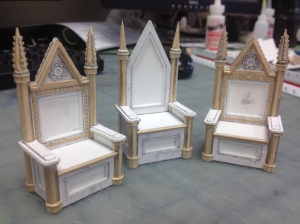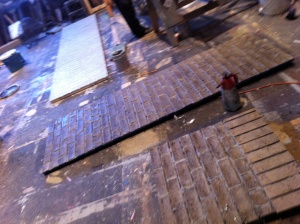Last week in the studio I completed a ¼” Bowmer model box and we’ll hopefully find some other opportunities to get me back in there when I’m not needed in the paint shop. It was so great to get back into model building having not done it for about six months. It really got me thinking about the upcoming designs I have for my senior year at Ithaca College. First is Anon(ymous) by Naomi Iizuka and then Tom Stoppard’s Arcadia. Rick Anderson showed me the software he used to fabricate complex model pieces on the printer and if I can figure out how to use within the next year, I really ought to explore the resources at Cornell University right across town in Ithaca to see what 3D printing equipment they have in their architecture department and see if I can utilize it! Rick’s recommendation to learn more CAD software is daunting, but it will make me more marketable so I might as well get the student deals while I still can!
This week I’m back in the paint shop and all of our forces went towards painting the two sarcophagus’s for Antony & Cleopatra. A lot of meticulous work was put into them taping them out, applying reeds to add dimension, gold leafing, and painting the multiple colors in a particular pattern. We got the point where everything was covered by the end of the work-day on Tuesday and I can say that they still looked amazing at the preview that evening. Going to the preview in the Elizabethan Theatre and seeing the half-timbering made me want to go back to London. The last show I saw during my semester there was Romeo & Juliet at Shakespeare’s Globe. I stood in the queue for two hours to get a returns ticket and paid five pounds to be a groundling right at the foot of the stage. The show went on even with consistent rain and I was prepared to outlast another Shakespeare in the rain, but being in Row L meant my seat was dry! The rain did clear up anyway and it was incredibly satisfying to see some of the work I’ve done finally be onstage.














































